#grand canyon railway 4960
Explore tagged Tumblr posts
Text
Me and my friend chased 4960 with the Speeder for an event the other day
20 notes
·
View notes
Text
GCRY No. 4960 departing the depot with a voice crack
45 notes
·
View notes
Text

Grand Canyon Railway’s No. 4960, a 2-8-2 Mikado
1 note
·
View note
Text
Grand Canyon Railway’s 100-Year-Old Steam Engine Runs On French Fry Oil
The Grand Canyon Railway is using recycled waste vegetable oil as fuel on No. 4960, a steam engine built in 1923. On select days from now through October, this massive steam engine will pull the daily train running from Williams, AZ to South Rim, Grand Canyon. WILLIAMS, ARIZONA, April 2022 – It sounds counter-intuitive: a 100-year-old steam engine will chug into Grand Canyon National Park to…
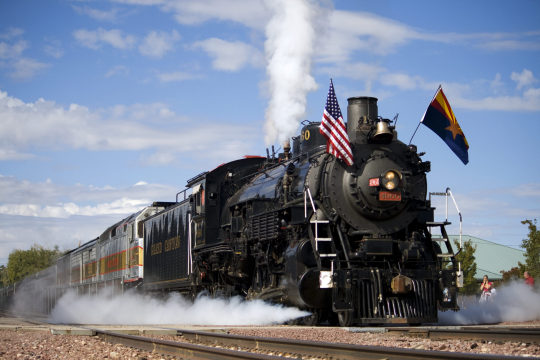
View On WordPress
0 notes
Video
The "greenest" steam train in America por Kevin Madore Por Flickr: At least that's how they bill today's Grand Canyon Steam operations. Both of the line's two steamers are converted coal-burners, each now fueled by some sort of bio-degradable vegetable oil. Although some say the exhaust smells like french fries, it still smelled like regular waste-oil to me. Consolidation #29 seen here running in Coconino Canyon, was built in 1906 by the American Locomotive Company in Lima, Ohio to haul iron ore trains on the Lake Superior & Ishpeming Railroad in Michigan. The long-serving engine was finally retired by the LS&I in 1960, and changed hands a couple of times over the next three decades, before coming to the Grand Canyon Railway in 1989. It entered service on the GCRX in 1990 and operated until 1995 when it was sidelined for a major overhaul. It re-entered service in 2004 and ran until new ownership decided to suspend steam operations in 2008. Although it had a relatively fresh FRA Form 4, it was parked and used as a display locomotive for the next 8 years. Finally, in 2016, for the 100th anniversary of the National Park Service, the 29 was restored to operating condition and has been alternating with the 4960 on the line's monthly steam weekend runs. If you've never seen this big Consolidation run, get yourself out to Williams sometime in the next couple of years. Her current Form 4 expires in 2019 and there are no guarantees after that.
10 notes
·
View notes
Text
Hey, Elon, I got a Proposition!

Someone asked me to answer this on Quora, and well, I actually do have an answer for it! And it’s pretty awesome.
I’m smiling because I’m actually trying to answer this myself.
And no, I’m not kidding. YES YOU CAN DO THIS, AND I’VE NOW GOT THE NUMBERS TO PROVE IT! I racked this with a good mechanical friend of mine, and another who maintains the boiler at his job. Basically, I’ve consulted people who know what they’re doing.
Basically, I decided to take a fictional locomotive from a very famous children’s story and see if I can stuff a bunch of Tesla battery modules up its tender, and add regenerative braking to said locomotive. Which actually would be better than the dynamic braking used by diesels today. One reason is how regenerative braking works when it comes to shoving a bunch of Tesla batteries up said locomotive’s tender. Though we can do half and half. And granted the locomotive has air brakes, we can just do regenerative blended braking.
On top of…converting said locomotive into a waste vegetable oil burner…which is an actual thing and two steam locomotives currently burn waste vegetable oil.
WVO is wasted cooking oil, namely veggie oil that restaurants use and then must dispose of after they use it. Using waste veggie oil actually saves on water, water that you have to add to cooking oil to even get it to be properly converted into biodiesel. Basically, frying a whole pot of chicken does the work for you. You just need to strain all the stuff you don’t want from the oil and use a fuel injector and atomizer in the firebox to spray the WVO fuel in.
And the fireman’s duties are now to adjust how much is being atomized, as well as the occasional dumping of sand in the firebox which helps keep the fire tubes unclogged. And said dumping of sand is literally not that much. It’s a little bucket and the guy has a small spade and plops a small scoop in.
The two locomotives that are the first to be converted to WVO are the GCR No. 4960 which is a Mikado 2–8–2, and the GCR No. 29 which is a Consolidated 2–8–0. Both locomotives do not use coal at all, only the wasted cooking oil that the restaurants ran by the park’s railways throw out, and for water, only snow melt is used.
Basically these two locomotives that run on the Grand Canyon Railway are carbon neutral burning locomotives. They are THAT clean. They actually did try various other fuel, including diesel! Yes, those two locomotives…burned diesel in their fireboxes once!
So the locomotive in question for this particular experiment that will answer your question is the fabled Gresley 4–6–2 Pacific prototype A0. Said locomotive does not exist in life, but on paper. However, a reverend by the name of Wilbur Awdry made this prototype exist in his book series.
I’m talking about Gordon. The posh, snobbish, galloping, blue sausage himself.
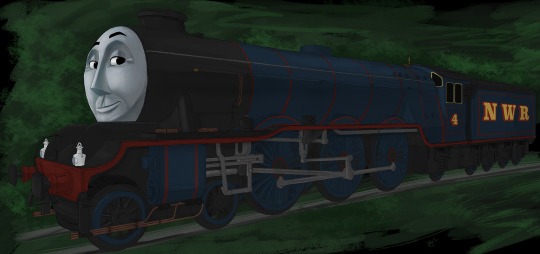
I’ve had fun with this guy. I chose him because of his rather unique attributes and a certain race that though he did lose due to plot convenience and I’m gonna call it that because every boilerman I’ve either spoken with or read in blogs who have looked at the footage from the movie The Great Race all said that Gordon actually had the capacity to defeat the SNCF BB 9003…an electric locomotive that had a top speed of 200 miles per hour. All Gordon needed was a little streamlining to do it. Apparently Gresley built the first steam locomotive that runs on pure awesome.
Basically, Gordon is mainline high speed passenger train material. He always was, but now it’s like…move over Mallard level of high speed. So it would be feasible and possibly even very likely that for the future of the Northwestern Railway, upgrades to Gordon would be required to meet ever changing timetable demands.
And luckily for Sir Topham Hatt, upgrades are easy thanks to him being a prototype. It’s easier to interchange his parts than it would be for a mainline model.
This is why I chose Gordon for this little experiment. Also we’ve got a lot of specs on the guy. And a few possible Gresley-drawn blueprints of the actual, but never built A0. Which included his boiler PSI, and this is important…and that PSI is closer to an A3 than an A1. A1s had 210psi, and Gordon had 220psi. And I have a feeling it might be higher than that…given the performance he gave during that movie and the fact that even with all those problems, he was more than capable of traveling from Knapford to…somewhere close to Manchester…BOTH WAYS!
I’m going with the theorized 250 psi for Gordon.
The other reason for choosing Gordon is well, the weight of the locomotive. The locomotive that is Gordon is around 103 to maybe 105 tons. Very light weight compared to American locomotives of the same Pacific wheel arrangement. This is again key because lighter weight means less fuel and water used, and higher speeds. You want this. Total weight including the tender, Gordon’s around 160 tons. I’m intending to give him two tenders…because…well…where else is he gonna store 67 Tesla Model S battery modules? So, he’ll probably top out a little over 200 tons.
And now you know why he’s often made fun of due to his weight.
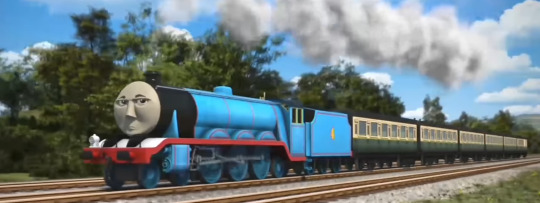
Don’t look at me like that, Gordon. You know you’re a fat ass.
Ahem...
This moves you closer to the goal of making a feasible steam locomotive.
Next, we get to the fuel as well as exhaust. They go hand and hand. To reduce fuel and water consumption in steam engines running in Britain, Gresley class locomotives and others had installed in their smoke boxes a new type of blast pipe called the Kylchap exhaust. This cuts down on fuel consumption and also cuts down on water. Adding two of these to the smoke box doubles the output of the locomotive. This is why the Flying Scotsman has two chimneys (funnels) instead of one.
So, let’s apply that to Gordon’s smoke box. Which as you can see, I’ve done in the image. The elongated chimney is similar to that of the Scotsman. So now, he’ll burn less fuel and use up less water, which allows him to run even longer. Couple that with converting him over to a waste veggie oil burner…we’ve just made Gordon into a carbon neutral steam engine. So, we’re one step closer to making Gordon a practical steam engine that can go anywhere he wants without people having a hissy fit over fires he might cause or soot, or whatever. Essentially, he stops being an insurance nightmare and he becomes officially green technology.
Now we’ve run into the issue that people often will point out about steam engines. Why we switched from steam to diesel. Or specifically from external combustion to internal combustion. Steam engines, although they are cool to see, convert only 10% of the heat they make into energy for movement. The rest is thrown up into the air through the smoke box. And in Gordon’s case, he probably uses 50% of that wasted heat to talk about how absolutely special he is. Well, we don’t want him to do that, we want to Gordon to get the most energy out of his heat.
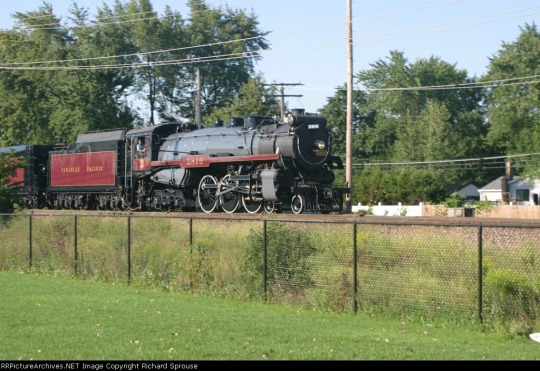
American steam engines solve this problem with a feed water heating system. Ambient temperature water is taken from the tender, into an injector which is then fed up into a bonnet over the firebox that is heated using the exhausted heat, the exhausted heat is around 1400ºF, and that heats the water to over boiling…and then it goes into another injector that pumps that into the boiler. This maintains the temperature in the boiler, which you want, uses the wasted heat that would just go up into the air…to preheat the feed water from the tender and prevent boiler shock, which you also want.
This also again conserves fuel, and it’s steam powered.
Gresley attempted to apply this interesting thing to his A1 Pacifics, specifically Gordon’s now scrapped brother White Knight.
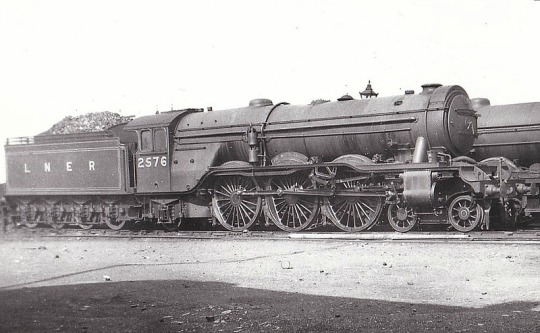
Unfortunately, the benefits gained through this system were lost thanks to high maintenance of the system itself. So, Gresley opted out of the feed water heater system and used a system that does the same thing, but uses less parts to do it with. So Gordon has an exhaust steam injector. It basically does the same thing, still heating the feed water from Gordon’s tender with the exhausted steam inside his smoke box, and then dumping that heated water into Gordon’s boiler.
And again, it’s all steam powered, so it uses the excess heat that normally would be lost to the sky, into making our locomotive more efficient. The drawback is when we’re firing Gordon up, that to heat the water, we need live steam rather than exhaust steam. This is was an issue with the exhaust steam injectors, and we’ll solve with our little Tesla powered heating system.
But we’re still not there.
Let’s go into the other reason why steam engines are not very efficient…having to each morning light the firebox in order to slowly bring Gordon’s boiler temperature up to proper steam pressure in order to make him move. You cannot rush this. Depending on boiler size, you are supposed to take anywhere from 3 hours to 6 hours or even 8 hours to slowly bring a steam engine under steam. And again, they use live steam to heat the boiler, which makes bring Gordon fully under steam a slow process.
To do it faster, you risk boiler integrity and Gordon’s boiler explodes. You don’t want that. I don’t think he’d appreciate his intestines flying everywhere.

Picture Source: The-ARC-Minister
That is still disturbing to look at.
You have to be careful when hand firing a steam engine and raising steam. How did we fix this problem before? Well, various workshops and roundhouses would have an external boiler that would preboil water and then put it into the steam engine while it’s resting over night.
Did any of you Thomas fans ever wonder why the steam engines were just ready to go in the morning like magic? It’s because Tidmoth Sheds has an external boiler to introduce live team into them so that they won’t have to wait for the guy who hand fires them in the morning to slowly bring them fully under steam. And hand firing a steam engine is EXTREMELY DANGEROUS!
There have been cases of crew members maintaining temperature of the steam engine while spending a night somewhere by burning what all they could in the steam engine so they didn’t have to worry about slowly raising steam. They just never extinguished the firebox.
We’re gonna go a different route with Gordon. And this is where Tesla comes in.
This is also how Gordon can get his dynamic braking, or rather regenerative braking because that’s better for Gordon than dynamic braking, and still serves the same purpose. And well with regenerative, you can still employ dynamic braking.
Gordon and his brothers and cousins don’t use air brakes like American steam engines do, they use vacuum braking. It’s why to make the Flying Scotsman street legal, they had to install air braking on top of the American loud chime whistle, bell, and high intensity headlamp.
We’re gonna rip Gordon’s vacuum brakes out and shove blended/regenerative braking in. But to do that, he needs a mechanism to power these brakes. Steam provided that mechanism at first, and yes he does have a dynamo, but that’s only good for powering the lights.
Don’t worry, he won’t mind if we rip something out of him. Back in 1939, Hatt had William Stanier, yes THAT William Stanier, rip Gordon’s Gresley conjugated valve gear and replaced it with a 2 cylinder Walschaerts valve gear. It actually increased Gordon’s tractive effort. Again, another good thing!
Let’s shove a bunch of Tesla car battery modules up Gordon’s tender. About maybe 67 should be enough. Yeah, we need two tenders. The numbers we ran to fully power Gordon with Tesla modules required basically 100 of those modules in his tender. But we’re turning Gordon into a hybrid, not a fully electric steam locomotive. We want enough to maintain boiler temperature during idling and when he’s tucked snugly in his shed. And enough to power his dynamic/regenerative braking, and perhaps enough to help in powering the coaches he pulls.
This is a Tesla Model S module.

We’re gonna shove 67 of those up Gordon’s tender to create a battery powered preheater to his water and help insulate his boiler to retain heat when he’s all snuggled up in his shed. We’re gonna make a big electric blanket for Gordon so he won’t have to wake up with a cold boiler anymore.
We’re wanting to make Gordon practical. And well, we have. In reality, there is a railway which have steam engines that use a variant that I’m describing for Gordon.
Brienz Rothorn Railway is a railway in Switzerland and the steam locomotives are rather unique. They are a real world example of the modern steam locomotive and how we can create a modern railway using steam locomotives. Which includes something that I’m gonna put in Gordon, a way to preboil water using electricity from a battery installed in the locomotive itself which cuts the time of slowly raising Gordon to steam, pretty much turning 8 hours to 1.
In fact, it takes about 30 minutes to an hour to get a diesel engine revved up for service as well, which is why railways such as Norfolk and Southern are implementing a similar system for their diesels so that they can be up and running even faster especially during freezing cold weather. We’re just doing this for Gordon. And why Tesla? Does electric semi-truck tell you anything? Of course our real world Tony Stark would want to see if it’s possible to run a steam engine using his batteries.
Even if it’s a publicity stunt.
So, we have our steam engine, we have a way to make said steam engine carbon neutral. We have ways to make said steam engine more efficient using both the technology that was invented at the time of Gordon’s construction, and today. And now we have a way to not only insulate Gordon’s boiler to prevent heat lost during idling or when we’ve tucked him to bed at night as well as making sure he has his coffee in the morning so he can be up and ready.
So what’s the point of having the batteries for Gordon’s electric boiler blanket if we can just hook the big guy up to Norfolk and Southern’s SLEEPER system instead? I’m sure he wouldn’t mind having a power cord sticking out of his tender some times. Those batteries power the new advanced braking.
So let’s go ahead and rip out that braking system and replace it with a new one.
I suspect that modern NWR would have replaced the vacuum brakes of its steam engines with air brakes at least. Because those things became obsolete in the 70s. We’re giving Gordon regenerative braking. Regenerative braking is something that was applied to a steam locomotive one time. General Motors created four types of steam locomotives, all were scrapped…utilizing electric turbines!
Meet Jawn Henry! The electric steam turbine locomotive. And if it weren’t for dieselization, we would have continued researching to improve this massive behemoth.
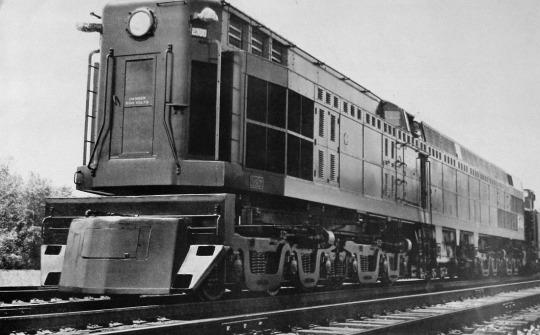
Yeah, the same thing they used to make power in a power plant, they decided to put that in a locomotive. And on top of that, they had regenerative braking. My friend in this project, since we’re using Tesla, and this is Elon we’re talking about…suggested shoving 3.5 Model S Tesla motors up Gordon’s bogey, which will coincide with the regenerative and blended braking.
I suggested Gordon doesn’t need this, BUT we are also thinking about possible breakdowns that might happen en route. So…yeah…Gordon switching over to his 3.5 Model S motors might be a good thing? But then if we do have the 3.5 Model S motors, why do we need Gordon? Well, unfortunately, the numbers we ran only say the motors are powerful enough to move Gordon himself, not the train he pulls. And certainly not at the speed we need him to be at. The motors act like attaching a diesel to the back of Gordon’s tender.
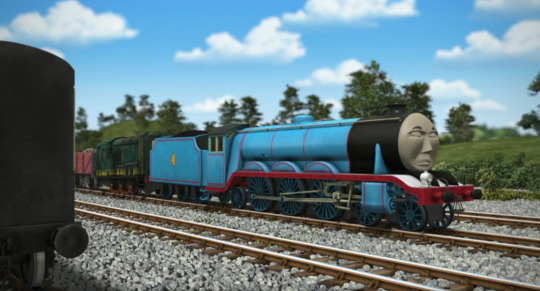
Um, example A? I think Gordon would much rather have Tesla motors in his bogey than Paxton shoving against his tender when he breaks down.
The purpose there is for potential mechanical issues, power to the coaches, and powering regenerative braking to Gordon.
The system, much like a system in a hybrid car, monitors idling time Gordon has verses running time, and during down time switching between firebox heat and battery heat. While still keeping the pilot light going so Gordon’s not using his fuel up. And in the mornings all you have to do is light Gordon’s firebox, but he’s pretty much at a good head of steam to start off already thanks to the preheated water.
And the 3.5 Model S motors provide power to the regenerative and blended braking which I suggest to my buddy whom I had this rather long discussion with. Regenerative braking coupled with the motors actually charges the batteries. So every time Gordon applies the brakes, he’s charging his heating blanket.
And this is how we turn a steam engine into something possibly practical.

Maybe.
In conclusion, we’ve reduced the steam engine’s carbon footprint with the WVO fuel, reduced the amount of fuel and water it uses with the Kylchap exhaust system, maximized the conversion of wasted heat from the engine with exhaust steam injector, gave the steam engine an electric blanket to sleep under at night, and coffee in the morning which makes the time the steam engine takes to get started a lot less. And with that electric blanket, we’ve now given it a proper regenerative/blended braking system and secondary “get out of dodge” method just in case the engine brakes down during an excursion. Because we don’t want the engine to tie up the line.
And now Gordon doesn’t have to listen to all those mechanically inclined people telling him what a literal waste of energy he is.
This was an exercise that we did when we were bored and there was nothing on TV.
I’m sure someone can come along and possibly suggest something better than this.
And if you’re really curious, we did run the numbers for if we just say…let’s get rid of Gordon’s firebox altogether and make him a completely electric steam engine. You know how many battery modules we would need to shove up Gordon’s tender to make that a possibility? About 100 or more. It’s why I told him that it’ll be better if Gordon was a hybrid. It’s just not practical to power up a steam engine using lithium batteries.
So we’re supplementing Gordon’s power with WVO and the batteries. Adding the electric traction motors…aka the 3.5 Model S motors. And using electric motors to supplement the steam power, allowing the boiler to run at lower PSI and fuel input rates, and increase overall efficiency.
I think we got a steam locomotive even the diesels will be jealous of. Yay?
All we need to do is get Tesla involved.
Remember, this is just a fun theory we worked out, and I’m still tweaking it as I go as I discover new things about modern steam power.
HEY, ELON! HOW WOULD YOU LIKE TO INVEST IN THE MOST ADVANCED AI IN THE WORLD...THAT’S LITERALLY CAPABLE OF ABSTRACT THOUGHT?! We call him Gordon Gresley.
37 notes
·
View notes
Video
Chicago Burlington & Quincy #4960 by Kevin Madore Via Flickr: The Grand Canyon Railway's big Baldwin Mikado #4960 started life in 1923 as freight hog hauling iron ore and other freight on the Chicago Burlington & Quincy, otherwise known as "The Burlington Route." This engine was "retired" from active service on the line in 1960, but continued to pull fan trips on the line for more than a dozen years. She was purchased by the newly developled Grand Canyon Railway in 1989 and underwent an extensive rebuilding effort that not only made her good for another half century of operation, but it changed her look rather significantly. Although she was "born" as a coal-burner, she's oil-fired now. The monstrous new tender that she sports carries significant supplies of both oil and water for the long runs from Williams to the Grand Canyon Village.
7 notes
·
View notes
Photo

Rare “Double-Head” Steam Engines #4960 & #29 Will Run on Weekend of Sept. 21-22 to Celebrate 30th Anniversary of Return of Passenger Service from Williams, Arizona to South Rim, Grand Canyon and 100th Anniversary of Grand Canyon National Park Grand Canyon Railway will “double-head” (run two steam engines together) its two operational steam engines on Saturday, September 21, to celebrate the 30th anniversary of Grand Canyon Railway’s return to passenger service from Williams, Arizona, to South Rim, Grand Canyon.Today finding a living, working steam engine pulling a real train that’s going somewhere in the U.S.
0 notes
Text
GCRY No. 4960 shoving into the depot with a bit of a squeak
28 notes
·
View notes
Text
Just an iron beast shoving into the depot before releasing a howl
#my video#Grand Canyon Railway#GCRY 4960#steam engine#steam locomotive#2-8-2 mikado#o1a class#CB&Q 4960
141 notes
·
View notes
Text
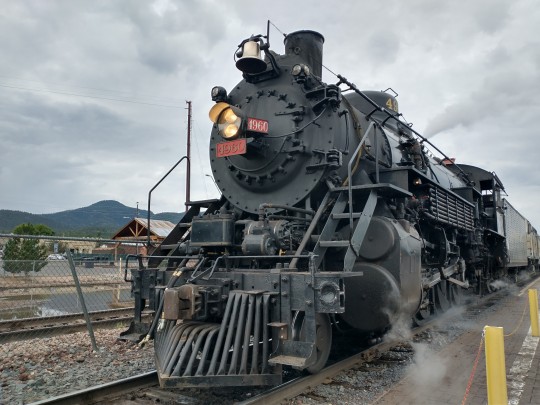
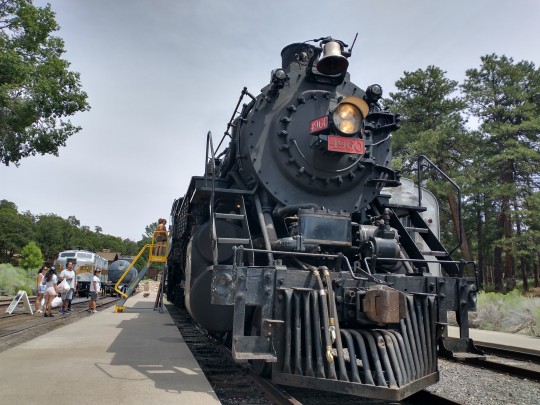
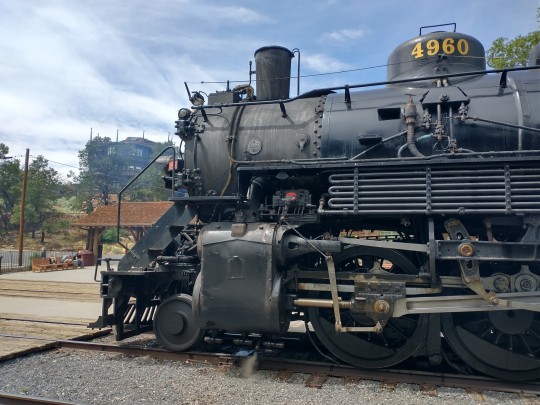


#Grand Canyon Railway#GCRY 4960#my photography#CB&Q 4960#birthday boy just turned 100 years old#railroading#steam locomotive#steam engine#train
116 notes
·
View notes
Text
I took this video back in March 5th, what a beast
#grand canyon railway#gcry 4960#grand canyon railway 4960#my video#steam engine#steam locomotive#steam whistle
78 notes
·
View notes
Text

See you next year, old pal
#gcry 4960#gcr 4960#this was the last Steam Saturday of 2022#grand canyon railway#my photo#photography#steam locomotive
47 notes
·
View notes
Video
The "greenest" steam train in America por Kevin Madore Por Flickr: At least that's how they bill today's Grand Canyon Steam operations. Both of the line's two steamers are converted coal-burners, each now fueled by some sort of bio-degradable vegetable oil. Although some say the exhaust smells like french fries, it still smelled like regular waste-oil to me. Consolidation #29 seen here running in Coconino Canyon, was built in 1906 by the American Locomotive Company in Lima, Ohio to haul iron ore trains on the Lake Superior & Ishpeming Railroad in Michigan. The long-serving engine was finally retired by the LS&I in 1960, and changed hands a couple of times over the next three decades, before coming to the Grand Canyon Railway in 1989. It entered service on the GCRX in 1990 and operated until 1995 when it was sidelined for a major overhaul. It re-entered service in 2004 and ran until new ownership decided to suspend steam operations in 2008. Although it had a relatively fresh FRA Form 4, it was parked and used as a display locomotive for the next 8 years. Finally, in 2016, for the 100th anniversary of the National Park Service, the 29 was restored to operating condition and has been alternating with the 4960 on the line's monthly steam weekend runs. If you've never seen this big Consolidation run, get yourself out to Williams sometime in the next couple of years. Her current Form 4 expires in 2019 and there are no guarantees after that.
9 notes
·
View notes
Video
Section House ruins at Willaha Siding by Kevin Madore Via Flickr: Grand Canyon Railway 4960 charges southbound past the ruins of an old Section House on the siding at Willaha, around MP 37.7. The ruins of several such structures line the 64-mile run from Williams to the Grand Canyon Village. This line was built in 1901 as a branch line on the Atchison Topeka & Santa Fe, and hauled both tourists and freight to the south rim of the Grand Canyon until 1968. By then, Highway 64 was the primary means by which tourists reached one of America's most scenic National Parks. The line continued to function as a freight line until about 1974, when it was basically abandoned. Over the course of the next decade and a half, a number of attempts were made to revive the line as a tourist operation, but none succeeded until 1988 when Max and Thelma Biegert developed the present-day Grand Canyon Railway. The line operated all-steam operations for many years, until it was taken over by Xanterra in the 2007 timeframe. Since that time, the line has operated primarily with diesel power, using steam on special occasions.
3 notes
·
View notes
Video
A full gallop at MP 35.3 by Kevin Madore Via Flickr: In a demonstration of the fact that the Grand Canyon Railway may just be America's fastest steam tourist run, the former CB&Q #4960 makes a 40 mph dash down the straight-away at MP 35.3. This train typically needs to cover the 64 miles between Williams and the Grand Canyon Village in about 2 hours & 15 minutes, so there's no room for slow operations. The track on this line is in extremely good condition and more than up to supporting 40 mph operations on a regular basis.
3 notes
·
View notes

